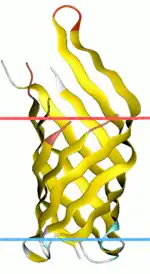OmpA-like transmembrane domain
OmpA-like transmembrane domain is an evolutionarily conserved domain of bacterial outer membrane proteins. This domain consists of an eight-stranded beta barrel.[1] OmpA is the predominant cell surface antigen in enterobacteria found in about 100,000 copies per cell.[2] The expression of OmpA is tightly regulated by a variety of mechanisms. One mechanism by which OmpA expression is regulated in Vibrio species is by an antisense non-coding RNA called VrrA.[3]
| OmpA-like transmembrane domain | |||||||||||
|---|---|---|---|---|---|---|---|---|---|---|---|
 | |||||||||||
| Identifiers | |||||||||||
| Symbol | OmpA_membrane | ||||||||||
| Pfam | PF01389 | ||||||||||
| Pfam clan | CL0193 | ||||||||||
| InterPro | IPR000498 | ||||||||||
| PROSITE | PDOC00819 | ||||||||||
| SCOP2 | 1bxw / SCOPe / SUPFAM | ||||||||||
| TCDB | 1.B.6 | ||||||||||
| OPM superfamily | 26 | ||||||||||
| OPM protein | 1qjp | ||||||||||
| |||||||||||
Structure
The structure consists of an eight-stranded Up-And-Down Beta-Barrel. The strands are connected by four extracellular loops and three intracellular turns.[4]
Function
Numerous OmpA-like membrane-spanning domains contribute to bacterial virulence by a variety of mechanisms such as binding to host cells or immune regulators such as Factor H. Notable examples include E. coli OmpA and Yersinia pestis Ail. Several of these proteins are vaccine candidates.
E. coli OmpA was shown to make specific interactions with the human glycoprotein Ecgp on brain microvascular endothelial cells.[5] Cronobacter sakazakii is a food borne pathogen causing meningitis in neonates and was shown to bind fibronectin via OmpA and this played a significant role in invasion of the blood brain barrier.[6] The Y. pestis protein Ail binds to laminin and heparin, therefore allowing bacterial attachment to host cells.[7] The Borrelia afzelii protein BAPKO_0422, is an OmpA-like transmembrane domain and binds to human Factor H.[8]
See also
References
- Pautsch A, Schulz GE (Nov 1998). "Structure of the outer membrane protein A transmembrane domain". Nature Structural Biology. 5 (11): 1013–7. doi:10.1038/2983. PMID 9808047. S2CID 20529728.
- Smith SG, Mahon V, Lambert MA, Fagan RP (Aug 2007). "A molecular Swiss army knife: OmpA structure, function and expression". FEMS Microbiology Letters. 273 (1): 1–11. doi:10.1111/j.1574-6968.2007.00778.x. PMID 17559395.
- Song T, Wai SN (July 2009). "A novel sRNA that modulates virulence and environmental fitness of Vibrio cholerae". RNA Biology. 6 (3): 254–8. doi:10.4161/rna.6.3.8371. PMID 19411843.
- Fernández C, Hilty C, Wider G, Güntert P, Wüthrich K (Mar 2004). "NMR structure of the integral membrane protein OmpX". Journal of Molecular Biology. 336 (5): 1211–21. doi:10.1016/j.jmb.2003.09.014. PMID 15037080.
- Prasadarao NV, Srivastava PK, Rudrabhatla RS, Kim KS, Huang SH, Sukumaran SK (Apr 2003). "Cloning and expression of the Escherichia coli K1 outer membrane protein A receptor, a gp96 homologue". Infection and Immunity. 71 (4): 1680–8. doi:10.1128/IAI.71.4.1680-1688.2003. PMC 152083. PMID 12654781.
- Nair MK, Venkitanarayanan K, Silbart LK, Kim KS (May 2009). "Outer membrane protein A (OmpA) of Cronobacter sakazakii binds fibronectin and contributes to invasion of human brain microvascular endothelial cells". Foodborne Pathogens and Disease. 6 (4): 495–501. doi:10.1089/fpd.2008.0228. PMID 19415974.
- Yamashita S, Lukacik P, Barnard TJ, Noinaj N, Felek S, Tsang TM, Krukonis ES, Hinnebusch BJ, Buchanan SK (Nov 2011). "Structural insights into Ail-mediated adhesion in Yersinia pestis". Structure. 19 (11): 1672–82. doi:10.1016/j.str.2011.08.010. PMC 3217190. PMID 22078566.
- Dyer A, Brown G, Stejskal L, Laity PR, Bingham RJ (2015). "The Borrelia afzelii outer membrane protein BAPKO_0422 binds human factor-H and is predicted to form a membrane-spanning β-barrel". Bioscience Reports. 35 (4): e00240. doi:10.1042/BSR20150095. PMC 4613713. PMID 26181365.